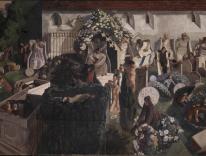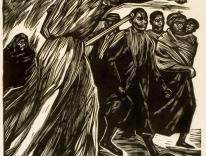The yard when we moved here was a tangle of phlox and ferns, a garden reluctantly abandoned by the old woman who lived here before us. Like neighbors who turn up blinking in the sun after a winter indoors, the descendants of these perennials reappear each spring. Today my grandchild Anne is in the garden at ease, a rare treat for a mother of an athletic two-year-old. But soon Jack wakes up, eager for action.
“Why don’t I take him for a walk?” I suggest, assuring Anne that we will return safe and soon. In spite of the hesitancy of her response, we embark, Jack belted into his stroller and I gripping the handle and listing slightly. I want Jack to see the little world where his grandmother and her brothers and sisters played-but we don’t see any children. Those deemed old enough are off to nursery school or play group; or they are in the house blinking at their caretakers’ soap operas. Many mothers are working elsewhere, contributing to the support of the mortgage.
Here comes an old settler like myself, the man for whom a dog was just prescribed as physical therapy. “After my heart attack,” he says, “I got Jerry from the Anti-Cruelty Society. Geraldine was my wife’s name, but I know she wouldn’t mind.” The man hurries on, explaining, ”I have to maintain a good speed for this to do me any good.” I should introduce him to Elsie, who borrows a dog from the couple who live beside her. “While they’re at work,” she explains, “Gretchen needs a couple of walks, and so do I. I’d feel foolish walking around by myself.”
“Walking should be a companionable activity,” I observe to Jack. “These old people should be walking together, airing their dogs, and recalling old times.” Jack has no comment.
We pause at a house where radical renovation is being finished off with paint in three fashionable colors. “When Tommy Cronin lived here about forty years ago,” I tell Jack, “the stucco was shabby gray. Tommy used to play in our sandbox. Your great-grandfather made it, and it could hold six children.”
As we pass beneath the maples that shade the sidewalk, I recall from an ancient past, “a tree that looks at God all day / And lifts her leafy arms to pray.” Sister Mary Charles Borromeo loved Joyce Kilmer, a poet twice-blessed among us fifth graders: not only a war hero (World War I, that is) but a Catholic. Her favorite Kilmer poem was about an abandoned house, “The saddest sight when it’s left alone that ever your eyes could meet.” I thought so, too, when I was ten.
Today, you could not apply Kilmer’s personifications, ascribing affection, chagrin, or disappointment, to an empty house. The place would not even have time to breathe a sigh of relief at the end of one family’s tenure. As soon as the moving vans roll down the street, here come the transforming architects, the floor sanders, carpenters, decorators as another family prepares to put the stamp of affluence on an old address.
Most families move on after a few years, but the houses remain, unless a shrewd investor has another idea. Then they are declared “teardowns,” replaced by something bigger and presumed to be better. Around the corner, an old bungalow is having its roof lifted, with a floor of bedrooms and baths added. “More room, Jack. That’s the prevailing impulse, even though there seem to be fewer people.”
As I consider all the additions being made, I see no evidence of subtraction. Yet quietly, behind an unchanging faÁade, this kind of change goes on as well. Consider the woman who can no longer reach her bedroom. Where she used to make the climb from the basement, carrying a laundry basket, now she finds the ascent daunting. Adjustments are discussed and implemented. Out go the Madeira napkins and the linen table cloth, leaving room for her socks and sweatshirts in that drawer. Without the long dining room table, there’s room for a bed. “For her, Jack,” I insist, “that’s a home improvement.” No word from Jack, but a happy holler.
For we have come to the little park, alive with children. Jack may not respond to questions about housing trends, but he knows a playground when he sees one, and bounces in his seat, anxious to get out, a possibility I had not considered when we left home. This is a busy place designed by specialists, filled with adventurous possibilities. Jack tolerates the baby swings for a few minutes but has other things in mind, involving curving slides, a wavy walkway five feet off the ground, a drinking fountain to splash in.
I try to interest him in a little garden that replicates the wild flowers and prairie grasses that stood here a hundred years ago, but he sees a higher slide and takes off. I push the empty stroller ahead of me, trying to catch up.
How glad I am to look up and see his mother, who has come to look for us. Competently, she takes charge, grabs her child, and secures him in the stroller. Relieved, I hold onto her arm. “What took you so long?” she wants to know as we head for home. I try to explain. “A journey like this takes time. Jack and I had a lot to look at and much to think about.” end


